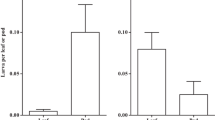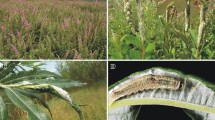Abstract
The plant genus Macaranga is known for its manifold mutualistic associations with ants. The plants provide food for the ants and in turn get protection from herbivores. Depending on the strength of the plant–ant interaction, the plant's investment in ants and the biotic defense derived from them is more or less effective. We conducted a comparative study on tannin content in 12 Macaranga species that were selected based on their associations with ants (three nonmyrmecophytes and nine myrmecophytes, three of which start their ontogeny as nonmyrmecophytes). Different developmental stages were investigated in three Macaranga species. Extracts of every individual plant analyzed for tannins were also tested for their effects on larval growth employing larvae of the common cutworm (Spodoptera littoralis). The studied Macaranga species differed significantly in their tannin contents as well as in the effects of their leaf extracts on the growth of S. littoralis larvae. A correlation analysis shows a connection between tannin contents and larval growth. High tannin contents and, thus more effective chemical defense, were observed in nonmyrmecophytic Macaranga species associated only facultatively with ants as compared to obligate myrmecophytes. Our study supports the hypothesis of a trade-off between chemical and biotic defense in the genus Macaranga.
Similar content being viewed by others
REFERENCES
ADLER, L. S. 2000. Alkaloid uptake increases fitness in a hemiparasitic plant via reduced herbivory and increased pollination. Am. Nat. 156:92-99.
AYRES, M. P., CLAUSEN, T. P., MACLEAN, S. F., REDMAN, A. M., and REICHARDT, P. B. 1997. Diversity of structure and antiherbivore activity in condensed tannins. Ecology 78:1696-1712.
BEATTIE, A. J. 1985. The Evolutionary Ecology of Ant-Plant Mutualisms. Cambridge University Press, Cambridge.
BERNAYS, E. A., COOPER-DRIVER, G., and BILGENER, M. 1989. Herbivores and plant tannins. Adv. Ecol. Res. 19:263-302.
BIDAL, C. 1997. Impact d'évolution des défenses biotiques sur l'élaboration des défenses chimiques et mécaniques des plantes à fourmis. Unpublished DEA thesis. University of Montpellier.
BLATTNER, F. R., WEISING, K., BäNFER, G., MASCHWITZ, U., and FIALA, B. 2001. Molecular analysis of phylogenetic relationships among myrmecophytic Macaranga species (Euphorbiaceae). Mol. Phylo. Evol. 19:331-334.
BRINKER, A. M. and SEIGLER, D. S. 1989. Methods for the detection and quantitative determination of cyanide in plant materials. Phytochem. Bull. 21:24-31.
BRYANT, J. P., CHAPIN, S. F., III, and KLEIN, D. R. 1983. Carbon/nutrient balance of boreal plants in relation to vertebrate herbivory. Oikos 40:357-368.
COLEY, P. D. 1986. Costs and benefits of defense by tannins in a neotropical tree. Oecologia 70:238-241.
COLEY, P. D., BRYANT, J. P., and CHAPIN, F. S. 1985. Resource availability and plant antiherbivore defence. Science 230:895-899.
DAVIDSON, D. W. and MCKEY, D. 1993. The evolutionary ecology of symbiotic ant-plant relationships. J. Hym. Res. 2:13-83.
DAVIES, S. J. 1996. The comparative ecology of Macaranga (Euphorbiaceae). Thesis. Harvard University, Cambridge, Massachusetts.
DAVIES, S. J. 1999. New species of Macaranga (Euphorbiaceae) section Pachystemon from Borneo. Kew Bull. 54:147-154.
DAVIES, S. T. 1998. Photosynthesis of nine pioneer Macaranga species from Borneo in relation to life history. Ecology 79:2292-2308.
FIALA, B. 1996. Ants benefit pioneer trees: The genus Macaranga as an example of ant-plant associations in dipterocarp forest ecosystems, pp. 102-123, in A. Schulze and D. Schöne (eds.). Dipterocarp Forest Ecosystems: Structure, Function, Ecology and Sustainable Management. Samarinda, Singapore.
FIALA, B. and MASCHWITZ, U. 1990. Studies on the South East Asian ant-plant association Crematogaster borneensis/Macaranga: Adaptations of the ant-partner. Insectes Soc. 37:212-231.
FIALA, B. and MASCHWITZ, U. 1991. Extrafloral nectaries in the genus Macaranga (Euphorbiaceae) in Malaysia: Comparative studies of their possible significance as predispositions for myrmecophytism. Biol. J. Linn. Soc. 44:287-305.
FIALA, B. and MASCHWITZ, U. 1992a. Food bodies and their significance for obligate ant associations in the tree genus Macaranga (Euphorbiaceae). Bot. J. Linn. Soc. 110:61-75.
FIALA, B. and MASCHWITZ, U. 1992b. Domatia as most important adaptations in the evolution of myrmecophytes in the palaeotropical tree genus Macaranga (Euphorbiaceae). Plant Syst. Evol. 180:53-64.
FIALA, B., MASCHWITZ, U., THO, Y. P., and HELBIG, A. J. 1989. Studies on a South East Asian ant-plant association: Protection of Macaranga trees by Crematogaster borneensis. Oecologia 79:463-470.
FIALA, B., MASCHWITZ, U., and THO, Y. P. 1991. The association between Macaranga and ants in South East Asia, pp. 263-270, in C. Huxley and R. Cutler (eds.). Interaction Between Ants and Plants. Oxford University Press, Oxford.
FIALA, B., GRUNSKY, H., MASCHWITZ, U., and LINSENMAIR, K. E. 1994. Diversity of ant-plant interactions: Protective efficacy in Macaranga species with different degrees of ant association. Oecologia 97:186-192.
FIALA, B., JAKOB, A., MASCHWITZ, U., and LINSENMAIR, K. E. 1999. Diversity, evolutionary specialisation and geographic distribution of a mutualistic ant-plant complex: Macaranga and Crematogaster in South East Asia. Biol. J. Linn. Soc. 66:305-331.
FOLGARAIT, P. J. and DAVIDSON, D. W. 1994. Antiherbivore defense of myrmecophytic Cecropia under different light regimes. Oikos 71:305-320.
FOLGARAIT, P. J. and DAVIDSON, D. W. 1995. Myrmecophytic Cecropia: Antiherbivore defenses under different nutrient treatments. Oecologia 104:189-206.
GAUME, L. and MCKEY, D. 1999. An ant-plant mutualism and its host-specific parasite: Activity rhythms, young leaf patrolling, and effects on herbivores of two specialist plant-ants inhabiting the same myrmecophyte. Oikos 84:130-144.
GAUME, L., MCKEY, D., and ANSTETT, M.-C. 1997. Benefits conferred by “timid” ants: Active antiherbivore protection of the rainforest tree Leonardoxa africana by the minute antPetalomyrmex phylax. Oecologia 112:209-216.
GERSHENZON, J. 1994. The cost of plant chemical defense against herbivores: A biochemical perspective, pp. 105-173, in E. A. Bernays (ed.). Insect-Plant Interactions, Vol. 5. CRC Press, Boca Raton, Florida.
HAGERMAN, A. E. and BUTLER, L. G. 1991. Tannins and lignins, pp. 355-388, in G. A. Rosenthal and M. R. Berenbaum (eds.). Herbivores: Their Interactions with Secondary Plant Metabolites, 2nd ed., Vol. I: The Chemical Participants, Academic press, San Diego, California.
HEIL, M. 1998. Quantitative Kosten-Nutzen-Analyse verschiedener Ameisen-Pflanzen-Assoziationen innerhalb der Gattung Macaranga. Wissenschaft & Technik Verlag, Berlin.
HEIL, M., FIALA, B., ZOTZ, G., MENKE, P., and MASCHWITZ, U. 1997. Food body production in Macaranga triloba (Euphorbiaceae): A plant investment in antiherbivore defence via symbiotic ant partners. J. Ecol. 85:847-861.
HEIL, M., FIALA, B., KAISER, W., and LINSENMAIR, K. E. 1998. Chemical contents of Macaranga food bodies: Adaptations to their role in ant attraction and nutrition. Funct. Ecol. 12:117-122.
HEIL, M., FIALA, B., BOLLER, T., and LINSENMAIR, K. E. 1999. Reduced chitinase activities in ant-plants of the genus Macaranga. Naturwissenschaften 86:146-149.
HEIL, M., STAEHELIN, C., and MCKEY, D. 2000. Low chitinase activity in Acacia myrmecophytes: A potential trade-off between biotic and chemical defenses? Naturwissenschaften 87:555-558.
HEIL, M., FIALA, B., MASCHWITZ, U., and LINSENMAIR, K. E. 2001. On benefits of indirect defense: Short-and long-term studies in antiherbivore protection via mutualistic ants. Oecologia 126:395-403.
HERMS, D. A. and MATTSON, W. J. 1992. The dilemma of plants: To grow or to defend. Q. Rev. Biol. 67:283-335.
HöLLDOBLER, B. and WILSON, E. O. 1990. The Ants. Harvard University Press, Cambridge, Massachusetts.
HUXLEY, C. R. and CUTLER D. F. (eds.) 1991. Ant-Plant Interactions. Oxford University Press, Oxford.
ITIOKA, T., NOMURA, M., INUI, Y., ITINO, T., and INOUE, T. 2000. Difference in intensity of ant defense among three species of Macaranga myrmecophytes in a southeast Asian dipterocarp forest. Biotropica 32:318-326.
JANZEN, D. H. 1966. Coevolution of mutualism between ants and acacias in Central America. Evolution 20:249-275.
JANZEN, D. H. 1973. Dissolution of mutualism between Cecropia and Azteca ants. Biotropica 5:15-28.
LETOURNEAU, D. K. 1998. Ants, stem-borers, and fungal pathogens: Experimental tests of a fitness advantage in Piper plants. Ecology 79:593-603.
LIN, J. H. 1993. Studies on tannins of the bark of M. tanarius (L.) Muell. Et Arg. J. Food Drug Anal. 1:273-280.
LIN, J. H. 1994. Studies on tannins from the bark of M. sinensis (Baill.) Muell.-Arg. J. Food Drug Anal. 2:201-209.
LIN, J. H., NONAKA, G. I., and NISHIOKA, I. 1990a. Tannins and related compounds XCIV. Isolation and characterization of seven new hydrolizable tannins from the leaves of Macaranga tanarius (L.) Muell. Et Arg. Chem. Pharm. Bull. (Tokyo) 38:1218-1223.
LIN, J. H., ISHIMATSU, M., TANAKA, T., NONAKA, G. I., and NISHIOKA, I. 1990b. Tannins and related compounds XCIV. Structures of macarangins and macarinins. New hydrolyzable tannins possessing macaronyl and tergalloyl ester groups from the leaves of M. sinensis Baill. Muell.-Arg. Chem. Pharm. Bull. (Tokyo) 38:1844-1851.
MARQUIS, R. J. and BRAKER, H. E. 1994. Plant-herbivore interactions: Diversity, specificity and impact, pp. 263-281, in L. McDade, G. H. Hartshorn, H. Hespenheide and K. Bawa (eds.). University of Chicago Press, Chicago, Illinois.
NOMURA, M., ITIOKA, T., and ITINO, T. 2000. Variations in abiotic defense within myrmecophytic and nonmyrmecophytic species of Macaranga in a Bornean dipterocarp forest. Ecol. Res. 15:1-11.
REHR, S. S., FEENY, P. P., and JANZEN, D. H. 1973. Chemical defense in central American non-ant acacias. J. Anim. Ecol. 42:405-416.
RHOADES, D. F. 1979. Evolution of plant chemical defense against herbivores. pp. 4-53, in G. A. Rosenthal and D. H. Janzen (eds.). Herbivores: Their Interactions with Secondary Plant Metabolites. Academic Press, San Diego, California.
RICKSON, F. R. 1980. Developmental anatomy and ultrastructure of the ant-food bodies (Beccarian bodies) of M. triloba and M. hypoleuca (Euphorbiaceae). Am. J. Bot. 67:285-292.
ROSENTHAL, G. A. and BERENBAUM, M. R. (eds.) 1991. Herbivores-Their Interactions with Secondary Plant Metabolites, Vol. 1: The Chemical Participants. Academic Press, New York.
SAGERS, C. L. and COLEY, P. D. 1995. Benefits and costs of defense in a neotropical shrub. Ecology 76:1835-1843.
SCHUPP, E. W. 1986. Azteca protection of Cecropia ant occupation benefits juvenile trees. Oecologia 70:379-385.
SEIGLER, D. S. and EBINGER, J. E. 1987. Cyanogenic glycosides in ant-acacias of Mexico and Central America. South West Nat. 32:499-503.
SIMMS, E. L. and RAUSHER, M. D. 1989. The evolution of resistance to herbivory in Ipomoea purpurea. II. Natural selection by insects and costs of resistance. Evolution 43:573-585.
SRIVASTAVA, R. P. and PROKSCH, P. 1991. Contact toxicity and feeding inhibitory activity of chromones from Asteraceae against Spodoptera littoralis (Lepidoptera: Noctuidae). Entomol. Gener. 15:265-274.
TURNER, M. 1995. Foliar defences and habitat adversity of threewoody plant communities in Singapore. Funct. Ecol. 9:279-284.
WHITMORE, T. C. 1969. First thoughts on species evolution in Malayan Macaranga (studies in Macaranga III). Biol. J. Linn. Soc. 1:223-231.
WHITMOTE, T. C. 1975. Macaranga, pp. 140-159, in H. K. Air-Shaw (ed.). The Euphorbiaceae of Borneo. Kew Bulletin Additional. Series 4. Kew Gardens, UK.
Author information
Authors and Affiliations
Rights and permissions
About this article
Cite this article
Eck, G., Fiala, B., Linsenmair, K.E. et al. Trade-Off Between Chemical and Biotic Antiherbivore Defense in the South East Asian Plant Genus Macaranga. J Chem Ecol 27, 1979–1996 (2001). https://doi.org/10.1023/A:1012234702403
Issue Date:
DOI: https://doi.org/10.1023/A:1012234702403




